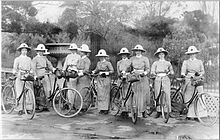District Nurse
As a District Nurse (dt. District nurse ) are in the UK , in Australia and New Zealand specialized nurses referred to in the community care and home care work. Your tasks include, for example, palliative care , wound management , urinary and faecal incontinence care and support with the supply of medication. The care of patients freshly discharged from acute care and the long-term care of the chronically ill are just as much part of their tasks as the cooperation with resident doctors to prevent unnecessary or avoidable hospital stays. In contrast to home care , which is widespread in German-speaking countries, district nurses are usually better qualified and have advanced skills in various areas.
job profile
District nurses visit and assess patients to determine whether they can stay in their homes with care support, maintain their independence, or whether they need additional support after they are discharged from hospital. A district nurse leads a team of nurses who provide wound care, catheter care, medication or vaccinations . In addition, the District Nurse offers advice and support on health issues and refers patients to other organizations.
education
In the UK, a District Nurse must be a trained adult care professional and be a registered nurse. An additional qualification acquired in a recognized advanced training course or a postgraduate course and admission by the Nursing and Midwifery Council (NMC) are then required. Additional training courses such as palliative care are common. District nurses with additional qualifications are allowed to prescribe certain medications as Community Practitioner Nurse Prescribers . They may also be qualified to prescribe needed resources and assist patients in applying for grants and welfare assistance.
history

The oldest known organization that allowed home nursing home visits in England was St Catherine's Royal Hospital in 1148. However, organized district nursing did not begin until 1859. In 1858, Liverpool philanthropist William Rathbone hired nurse Mary Robinson to help his wife during the last time of her fatal illness. After his wife's death, he continued to pay Robinson to visit one of the poorest districts in the city and to bring nursing care to those who did not have the means. He spent the rest of his life, with the support of Florence Nightingale , among others , to expand and maintain this supply. This model of district nursing spread quickly and was funded by local philanthropists in other cities and towns. In 1887, the Queen Victoria ’s Jubilee Institute for Nurses was established, which centralized education for district nurses until nursing education was nationalized in 1968. The institute needed constant financial support until the NHS was founded in 1948, which is why the District Nurses collected donations from their patients.
Outpatient care in Australia began in 1885 when a group of concerned citizens founded the Melbourne District Nursing Service . The aim of the organization was to care for disadvantaged sick people in their home environment. Since its inception, outpatient care has spread across the country and into all territories. There are now around 200 active organizations that offer modern equipment and basic and specialized care across Australia.
United Kingdom
In England , the District Nurses , also known as Community Nurse Specialists, were employed by the Primary Care Trusts , an administrative unit of the National Health System , until 2013 , and are now mostly employed by hospitals and community health departments. In Wales and Scotland , employers are centralized health centers or general practitioners' offices funded by the regional health department. State supervision is guaranteed by the NMC.
New Zealand
In New Zealand , District Nurses are usually employed by the district health departments, but there are also some nurses who work for private institutions. As in the UK, District Nurses have a range of specialized skills relevant to outpatient care, usually experience in the acute care clinical setting is expected. There is also a strong focus on preventive healthcare for specific patient groups, such as the prophylaxis of rheumatic fever. Because of their specializations and expertise, District Nurses are paid better than clinical nurses.
Australia
In Australia , District Nursing emerged mainly from voluntary or charitable organizations and was funded by the government. Major changes in funding through the National Disability Insurance Scheme have expanded patient choice, increasing competition in the care business space. Previously very extensive care organizations such as the Royal District Nursing Service have subsequently joined forces with smaller local care providers in order to be able to offer a broadly based model of home care.
public perception
District nurses have been featured in films and series, including the series Call the Midwife and The District Nurse and the 1963 film Nurse on Wheels .
literature
- Liz O'Brien: District Nursing Manual of Clinical Procedures , Wiley-Blackwell, 2012. ISBN 978-1405114592 (English)
- Sally Lawton, Jane Cantrell, Jane Harris: District Nursing: Providing Care in a Supportive Context Churchill Livingstone, 2000. ISBN 978-0443062506 (English)
Individual evidence
- ^ National Health Service : District Nurse (English), accessed June 13, 2020
- ↑ Liz O'Brien: District Nursing Manual of Clinical Procedures , Wiley-Blackwell, 2012 ISBN 978-1405114592 . Cape. I Assessment and Communication (English)
- ↑ Drug Tariff: Part XVIIB (i)
- ↑ Royal College of Nursing: Non-Medical Prescribers (English), accessed June 13, 2020
- ^ Year Book Australia: History of Home Nursing in Australia , Section Influence of England's District Nursing , 1985. Retrieved June 12, 2020
- ^ DistrictNursing.org: William Rathbone and the beginning of District Nursing (English) accessed on June 13, 2020
- ^ Ministry of Health New Zealand: District Nursing Development , 2011 (English) accessed on June 13, 2020
- ↑ Commonwealth of Australia, Australian Bureau of Statistics: History of Home Nursing in Australia, accessed on June 13, 2020
- ↑ Australia Government, Department of Health: Home Care Packages Program Reforms (English), accessed June 13, 2020
Web links
- Queens Nursing Institute: District Nursing Heritage
